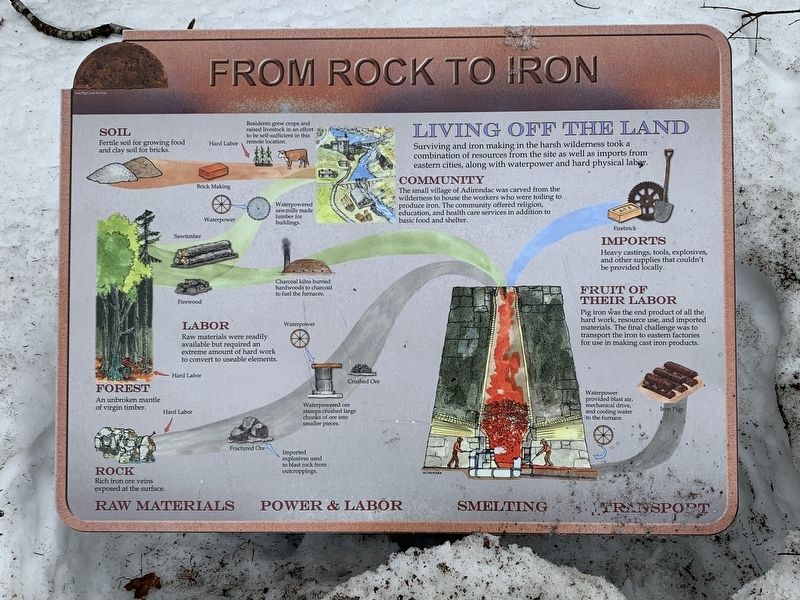Tahawus in Essex County, New York — The American Northeast (Mid-Atlantic)
From Rock to Iron
LIVING OFF THE LAND
Surviving and iron making in the harsh wilderness took a combination of resources from the site as well as imports from eastern cities, along with waterpower and hard physical labor.
Community
The small village of Adirondac was carved from the wilderness to house the workers who were toiling to produce iron. The community offered religion, education, and health care services in addition to basic food and shelter.
Imports
Heavy castings, tools, explosives, and other supplies that couldn't be provided locally
RAW MATERIALS
Rock - Rich iron ore veins exposed at the surface.
Forest – An unbroken mantle of virgin timber.
Soil - Fertile soil for growing food and clay soil for bricks.
POWER AND LABOR
Labor
Raw materials were readily available but required an extreme amount of hard work to convert to useable elements.
Labor produced
Rock – Fractured Ore
Forest – Sawtimber, firewood
Soil - Residents grew crops and raised livestock in an effort to be self-sufficient in this remote location.
Power and Labor produced
Forest - Waterpowered sawmills made lumber for buildings
Forest - Charcoal kilns burned hardwoods to charcoal to fuel the furnaces
Rock - Waterpowered ore stamps crushed large chunks of ore into smaller pieces
Rock - Imported explosives used to blast rock from outcroppings.
SMELTING
Waterpower provided blast air, mechanical drive, and cooling water to the furnace
TRANSPORT
Fruit of Their Labor
Pig iron was the end product of all the hard work, resource use, and imported materials. The final challenge was to transport the iron to eastern factories for use in making cast iron products.
Erected by Open Space Institute.
Topics. This historical marker is listed in this topic list: Industry & Commerce.
Location. 44° 5.282′ N, 74° 3.352′ W. Marker is in Tahawus, New York, in Essex County. Marker is on Upper Works Road (County Route 25) 9.8 miles north of Blue Ridge Road, on the right when traveling north. Touch for map. Marker is in this post office area: Newcomb NY 12879, United States of America. Touch for directions.
Other nearby markers. At least 8 other markers are within walking distance of this marker. The Money Men (here, next to this marker); Transportation (a few steps from this marker); Jennings Cottage (within shouting distance of this marker); W.R.K. Taylor Jr. (within shouting distance of this marker); Lazy Lodge (within shouting distance of this marker); Coe Cottage (within shouting distance of this marker); Taming the Wilderness (within shouting distance of this marker); Three Communities (within shouting distance of this marker). Touch for a list and map of all markers in Tahawus.
More about this marker. The Marker is a graphic flow chart showing all the inputs required to make iron at a remote outpost. Colored arrows show the transformation of specific raw materials and and the physical and mechanical labor into useful intermediates and finally into pig iron.
Credits. This page was last revised on April 15, 2020. It was originally submitted on April 13, 2020, by Steve Stoessel of Niskayuna, New York. This page has been viewed 84 times since then and 10 times this year. Photo 1. submitted on April 13, 2020, by Steve Stoessel of Niskayuna, New York. • Michael Herrick was the editor who published this page.
Editor’s want-list for this marker. A wide angle photo of the marker and its surroundings. • Can you help?
